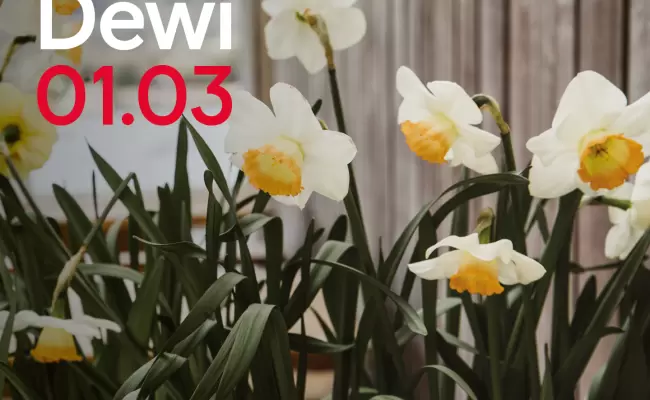One, the leek, is full of nutritional goodness and the other, the Welsh National Flower, is to be admired for its golden floral beauty.
Of course, you could also add the Welsh dragon which will fly high on Welsh buildings on St David’s Day, but that’s another story!
Come St David’s Day, Future Inns Hotel Cardiff will be adorned with daffodils, and, just like any other day, Chef will be including leeks in his traditional Cawl (soup) dish, from our Welsh dish selection in our Thomas Restaurant, which we have re-named ‘Tomos’ just for one day!
So how did leeks and daffodils come to be so celebrated as a means of honouring our patron saint in Wales? Why is it that so many attach this strong-smelling member of the onion family to their clothing or have vases of a distinct yellow flower on display?
Whilst the true origins may be lost in myth and legend, their history can be traced back at least 700 years.
The Leekies
- According to legend, this tradition dates right the way back to the 12th century when St David himself ordered soldiers, on the eve of a great battle with Saxons, to distinguish themselves from their enemy by wearing leeks on their helmets. It’s said this helped them to score a great victory. The battle itself is also said to have taken place in a field full of leeks.
- In an age-old ritual dating back to 1916 on the battlefields of the Somme in WW1, every St David’s Day, soldiers of the Welsh Guards are presented with ceremonial leeks. In turn, St David’s Day has become symbolic of their bravery.
- During Elizabethan times, Shakespeare refers to the custom of wearing a leek as an “ancient tradition”, and his character Henry V tells Fluellen that he is wearing a leek “for I am Welsh, you know, good countryman.”
- Leeks, like garlic and onions, belong to the Allium family of vegetables and contain many of the same beneficial compounds found in these well-researched, health-promoting vegetables.
The ‘Daff’s
- In old Welsh text, the word for daffodil and for leek are intriguingly similar: (Cennin = Leek, Cenhinen Pedr = Daffodil).
- It is not only Wales that benefits from the daffodil. In fact, the UK is the world’s largest producer of daffodils and makes £23 million per year from the daffodil cut flower industry. It produces half of the world’s daffodil bulbs, exporting 10,000 tons, worth £7 million to the economy.
- The wearing of a daffodil is said to have been popularised by David Lloyd George who adopted the daffodil in 1911 after our future Edward VIII as Prince of Wales had accepted the flower at his Caernarvon investiture. However, it was July, and old footage shows no daffodils actually present, but we know he was a real fan!
- The Prime Minister ordered for the daffodil to be placed in the Insurance stamps emblem in Wales. By 1917 the daffodil was woven into the watermark design of Treasury notes.
- Some consider the daffodil to be replacement for the leek. The daffodil is believed to closely resemble a leek flower and since they are more common than leek flowers, the daffodil is worn instead. They grow in abundance around the time of St David’s day and smell nicer!
- It’s appearance in early spring is considered by some to be a symbol of nature’s optimism which neatly coincides with St David’s Day.
- Daffodils are grown commercially in Mid Wales to produce galantamine for the treatment of Alzheimer’s disease.
- The Daffodil is the 10th wedding anniversary flower making it doubly relevant if you are Welsh and were married on St David’s Day.
- Even after a long winter, squirrels will not eat daffodil bulbs, as they contain poisonous crystals which only certain insects can eat.
Happy St David’s Day!

